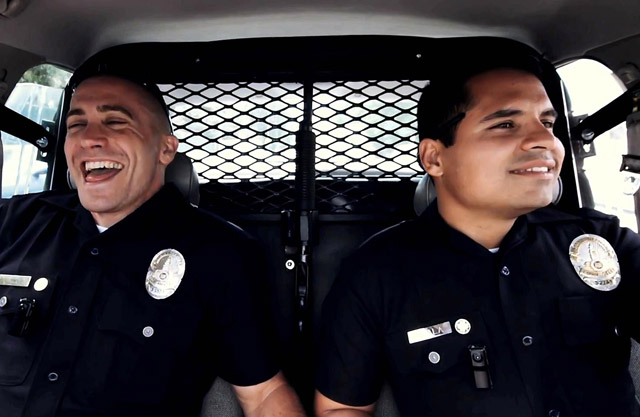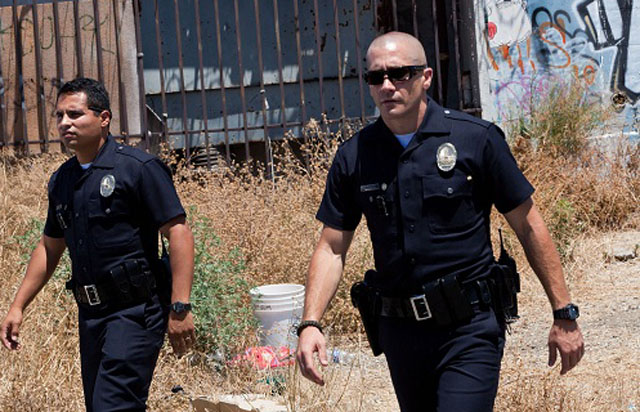CHICAGO – Patrick McDonald of HollywoodChicago.com appears on “The Morning Mess” with Dan Baker on WBGR-FM (Monroe, Wisconsin) on March 21st, 2024, reviewing the new streaming series “Manhunt” – based on the bestseller by James L. Swanson – currently streaming on Apple TV+.
Interview: Michael Peña, Director David Ayer of ‘End of Watch’
CHICAGO – The cop movie, an ongoing and speculative genre in both film and television, gets a welcome makeover in Director David Ayer’s “End of Watch.” This human story involves the lives of two Los Angeles police partners, and the street war that threaten to take those lives. Michael Peña turns in a soulful performance as one of those partners.
Following the path that Officers Taylor (Jake Gyllenhaal) and Zavala (Peña) take as they patrol the South Central streets in L.A., is to see the America that imminently could spin out of control. The film is a stark depiction of the “thin blue line” between safety and anarchy, plus the arsenal that is being built up against even the so-called “decent” law enforcers. Gyllenhaal and Peña create some deep mortality under the badges, flaws and all, and turn in some defining performances.
 Photo credit: Open Roads Films |
Michael Peña grew up on the streets of Chicago, working his way up through independent films starting in 1994. His big break came in two notable roles in two Oscar-winning Best Pictures, “Crash” and “Million Dollar Baby.” He also gave impressive performances in “World Trade Center” (2006), “Babel” (2006) and “The Lincoln Lawyer” (2011). The director of “End of Watch,” David Ayer, was the screenwriter for “Training Day” (2001) and has helmed two previous films, “Harsh Times” (2005) and “Street Kings” (2008).
HollywoodChicago.com interviewed Michael Peña and David Ayer during a publicity tour through Chicago in early September. They talk about the themes and techniques in “End of Watch,” including a reference to Clint Eastwood and his magic chair.
HollywoodChicago.com: Michael, this is a very emotional role, and you are very connected to it. Can you think of a similar situation in your own life that you were able to tap that is close to the camaraderie that was generated in the film?
Michael Peña It’s actually a Chicago story. I went to Marist High School initially, and one of the big sports was wrestling. I was curious to see what kind of wrestling it was, I thought it was going to be WWF, pro wrestling style. [laughs] When I showed up, the coach convinced me to join in. I was okay the first year, and made varsity the second year. I then transferred to Hubbard High School, and I was able to show my new team some new moves. We were the first wrestling team from the school to go to the downstate championship in thirty years. The connection in that situation was close to the film, but of course it was different.
The cop partner relationship in the film is more like a brotherhood, the wrestling team situation wasn’t life-or-death. Jake and I went through weapons training, going out through South Central and spending every day for four months together. It’s one thing to be friends, but it’s another thing to portray brothers. We carried on so much in the filming, that David would have to say ‘enough, you two.!’ It became that type of relationship.
HollywoodChicago.com: So David, those dayroom scenes with the assignment sergeant, that was just you trying to deal with those two?
David Ayer: That’s what it felt like, even though it was scripted. When they took the training, something clicked between them. There are layers to the characters, layers to the script and layers to Mike and Jake, that they brought to it.
Peña: There is one thing that Jake does when he busts on people, and sometimes you can’t tell whether he’s doing it. I got used to it, and then our sense of humor started to get in sync. But it was the acting rhythm as well, back-and-forth, back-and-forth. Sometimes it would be two words of improvisation that would help the scene, and we would do that all the time, just to let it breathe. We knew the entire script a month before shooting, and we would just drill it and drill it to get deeper to the meaning.
Ayer: Friendship comes from respect, and these two are so talented that it became a mutual respect. I’d watch them just hurl fireballs at each other, and then step back and say, ‘hey, you’re pretty good.’
HollywoodChicago.com: David, how many hours of footage did you shoot, and did you have a design for each multiple camera scene or did you just go in shooting and take care of it in post production?
Ayer: In tradition photography, there will be a shot list, which is a cookbook and a formula – master shot, cowboy, cowboy, single, single, Extreme Close Up, with 25, 50 and 75 lenses. I didn’t shoot this movie that way, I just knew the cameras I was using and styles of coverage. With that many cameras running, all in the digital space, with 25 minute magazines, I’d never call ‘cut.’ We’d just run the scene over and over again.
Peña: Which I appreciated, because I haven’t experienced that before.
Ayer: It’s a very freeing technique, but you do come back with a massive amount of footage to edit. It was the film equivalent of a million and a half feet in digital. To cut all that down to an hour and forty minutes was not an easy task.
Technically, Jake had a consumer camera with a professional digital chip. We used GoPro cameras, Canon 5Ds and re-invented the SI-2k to get it down to the size of a cigarette pack. It’s was a lot of work to get the equipment right, down to the vacuum formed vests with nylon harnesses that Jake and Mike wore, to get images I’ve never seen before. It has the effect that they’re in the world.
 Photo credit: Open Roads Films |
HollywoodChicago.com: This had the feel of ‘found footage,’ the popular trend of the digital age, but it was more a stylistic choice. Did you think that people might think it was under the found footage genre?
Ayer: You mean like ‘Blair Witch Project’ or ‘Cloverfield’? In my mind, that’s okay for specific genre film, but I didn’t want to take any tool off the table. There will always be film geeks who wonder ‘who is holding the camera?’ Who cares. [laughs] If your halfway through the movie and still wondering who is holding the camera, I’ve lost you.
HollywoodChicago.com: Michael, I’ve heard also that digital shooting is more freeing for the actor. Was this your first digital shoot?
Peña: ’30 Minutes or Less’ was all digital, but this was the one where the character seems always on camera. There were scenes that made me nervous and I wanted to do two takes in a row. In other films, they would be adjusting things between those takes and I’d lose the momentum. In this one, I wanted to fool people as to whether I was doing the dialogue or not, acting or not. That’s when I do my best work. This piece lent itself to that.
HollywoodChicago.com: You’ve played police officers before, do you have a significant part of their code that you take to heart, and use the most in your portrayals of police officers?
Peña: I didn’t do much training for the other films.
HollywoodChicago.com: Not the Oliver Stone film, ‘World Trade Center’?
Peña: In that film, I just did a lot of research of pain thresholds and what the pain does – like laughing to release the tension and pain. There was no policing in that film. In ‘Shooter,’ it was all plot driven stuff, so it wasn’t a policeman on the streets. I loved the great street cop movies as a kid, like ‘Serpico’ and ‘Dog Day Afternoon.’ This was the first authentic street cop I’ve ever played.
HollywoodChicago.com: David, how did you balance the authenticity of police work with the narrative that you needed to tell the story?
Photo credit: Patrick McDonald for HollywoodChicago.com |
Ayer: It’s interesting, because different things seem inauthentic to different people. In budgeting films there is a lot of money on the table, and I’m willing to let some slip some through my fingers in order to have a viewpoint. People were saying that the Mexican cartel stuff wasn’t real, but yes it’s there. The policemen we worked with are pulling those guys over every week, taking pounds of dope off of them. Others are saying that cops never come upon so much, but everything our characters encounter is what is happening in Los Angeles every week.
I have to have the story structure, the beginning, middle and end. You got to set stuff up and create situations. Sometimes the characters have to say something relevant to the plot, so you know what’s going on. What I didn’t do was create the ‘cartel-centric monster’ as a villain. If I personalized that story, it would take away from the two policemen in the car. It’s about the threats, and by keeping the evil masked and held back, I felt that I could make it work.
Peña: If you read the scenes in the car, it reads just like a play. You could do that whole section on stage. The dialogue was so awesome that we wanted to get it right. It was so specific, I memorized it exactly. It reminded me of David Mamet. The precision of the dialogue also connected to actions later in the script. I would ask, ‘why do I have to say it like that?’ David would say, ‘look on page 90.’
HollywoodChicago.com: David, you expressed the shadow law enforcement in the screenplay with scenes of Homeland Security. What is your opinion of this secret police, and when does the line of protection break down when it’s less transparent?
Ayer: If you’re not doing anything wrong, what do you have to worry about? [laughs]
Peña: Talk to the chair, bro. [laughs]
HollywoodChicago.com: Michael, what is interesting about your career is that you bounce between comedy and drama. When you finish something intense like ‘End of Watch,’ do you immediately want next to do a comedy?
Peña: I was just so tired after the intensity of this shoot. We did some of the scenes – between rehearsal and the shoot – over one hundred times. We didn’t get it at first, and we both were a little frustrated. But when we finally clicked, it was like a high like sports, a sense of accomplishment. I just wanted to continue that in what I chose next.
 | By PATRICK McDONALD |


